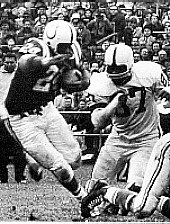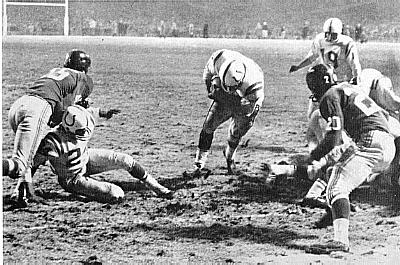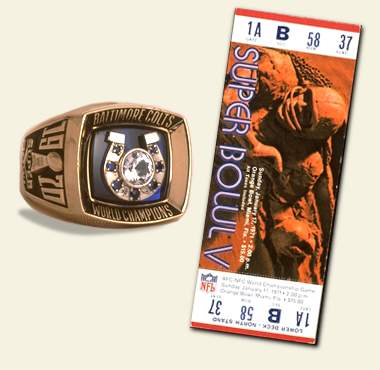 Latest Colts News Schedule & Weekly Recap Archive Sports Webrings the Infopedia Belongs To |
Life Before
Indianapolis: A History of the Baltimore Colts Note: My sincere thanks go out to Kurt Christopher of Albuquerque, New Mexico
for his assistance in compiling the early history of the Colts' franchise. -- MD In the Beginning Like the Cleveland Browns (who?) and the San Francisco 49ers, the Indianapolis Colts can trace their heritage to the All-America Football Conference (AAFC). The original Colts were founded in 1947, when the owners of the Miami Seahawks gave up their AAFC franchise after a disastrous 3-11 season that saw the team lose badly on the field and at the gate. Since the city was unwilling to support a marginally successful team (just like today), Robert Rodenberg transferred the franchise to Baltimore, where they were renamed the Colts. Baltimore mayor Thomas D'Alesandro Jr. formed a citizen's syndicate that kept the team from going out of business. In 1948, the club tied for the AAFC eastern title with a 7-7 record before losing in the playoffs to Buffalo. When the AAFC and NFL merged following the 1949 season, the Colts joined the Browns and 49ers as the three AAFC teams were admitted to the NFL. After losing 11 games in 1950 and considerable money at the box office, Colts owner Abraham Warner gave his franchise back to the NFL on January 18, 1951. Baltimore Colts II --The Long and Winding Road Although the original Colts franchise stopped playing after the 1950 season, the current Colts franchise can trace its roots even farther back to World War II. How can that be? you're probably asking. It may appear confusing on the surface, but after looking at the history of the team, it's not really that difficult to understand. Like the Washington Redskins, the current Colts franchise began play in Boston, Massachusetts. Known as the Boston Yanks, the franchise played in Boston from 1944 through 1948. At the time, they were owned by a gentleman named Ted Collins, who was once a manager for the easy-going swing singer Kate Smith. (For those too young to remember Kate Smith, she is best known in modern times for her stirring rendition of "God Bless America," which was played at home games for the Philadelphia Flyers hockey time for many years after her death.) In 1949, Collins moved the team to New York City, where they became known as the New York Bulldogs. The Bulldogs had little success sharing the Polo Grounds with their rivals, the New York Giants, so a year later a merger then occurred between the NFL's Bulldogs and the AAFC New York Yankees. Hereafter, the team would be known as an NFL franchise, but it would keep the name of its' old AAFC team. Even a switch from the Polo Grounds to Yankee Stadium couldn't help the Yankees compete against the Giants, however, so in 1951, before almost selling the team to a group of investors in Baltimore, Collins sold the franchise back to the NFL. In 1952, the old New York Yankees franchise was on the move again and became the Dallas Texans. At the time, a group of owners in the Dallas area were positive they could make Dallas a real hotbed of NFL action. The experiment failed miserably, however. Attendance was so bad, in fact, that the team gave up Dallas as its home midway through the season, playing the rest of its games on the road that year and operating from a base in Hershey, Pennsylvania. In 1953, the NFL had a team without a home -- the Dallas Texans. The city of Baltimore, meanwhile, was clamoring for another chance at having a professional football team -- so much so that a court case was filed against the league by an attorney named William D. MacMillan in an effort to try and bring a team back to Baltimore. Enter Carroll Rosenbloom. A Baltimore native who was fabulously wealthy, Rosenbloom was bored with business, and a good friend of then-league commissioner Bert Bell, who had coached Rosenbloom when he played at the University of Pennsylvania. Before agreeing to let another team operate in Baltimore, the commissioner and the rest of the owners in the league wanted an owner that had both deep pockets and a competitive spirit. Rosenbloom fit the bill in both categories. After some initial hemming and hawing, Rosenbloom agreed to buy the Colts back from the league. First, though, Bell issued a challenge to the city of Baltimore: sell 15,000 season tickets within six weeks, and you'll get a new franchise. It took less than four, which showed the devotion the city of Baltimore had with regards to obtaining a professional football team.. On January 23, 1953, a second incarnation of the Colts became the current National Football League franchise that exists today. Rosenbloom took over operation of the team, including any debts that had accrued during the operation of the franchise by the NFL. Local investors helped raise money to pay off the Washington Redskins and their 75-mile "territorial fee." And thus, pro football was reborn in the city of Baltimore. 1953: The Season it All Began The Colts began the 1953 season with a blockbuster trade, swapping five Baltimore players for 10 Cleveland Browns. Among the players who came over were future coach Don Shula; Bert Rechichar, Carl Taseff and Art Spinney, among others. With Keith Molesworth as head coach, the Colts struggled to a 3-9 season in their inaugural year. However, in 1954 Rosenbloom hired former Borwns assistant Wilbur (Weeb) Ewbank as the new head coach. Molesworth was switched to the team's head scout, and his keen eye for new talent paid off in 1955 when 12 rookies made the squad. Among them -- end Raymond Berry and fullback Alan Ameche. Bolstered by young talent, the Colts improved to 5-6-1 that year, then drafted halfback Lenny Moore, snagged defensive tackle Eugene (Big Daddy) Lipscomb off the waiver wire, and took a chance on a stoop-shouldered semipro quarterback named John Unitas.
In one of the less intelligent moves made by the Steelers, Unitas was cut by Pittsburgh and was playing for $6 a game for the Bloomfield Rams. He was originally signed as a backup to George Shaw but became a starter four games into the 1956 season when Shaw went down with an injury. Even with the switch at quarterback, the Colts continued to struggle on the field. With Ewbank's job reportedly on the line, Unitas launched a 53-yard touchdown pass to beat the Rams in the season finale and preserve Ewbank's position as head coach for another year. The Colts added another star in 1957, drafting a massive but agile tackle from Ohio State University named Jim Parker. That year, the Colts posted a 7-5 record. It was the first winning record for any Baltimore Colts team, but it was only a foreshadow of what was to happen next season. 1958: The Year it All Came Together When he first took over the team in 1954, coach Ewbank had promised a championship for the city within five years. In 1958, the Colts proved Ewbank a genius by winning their first division title with a 9-3 record. They then met the New York Giants for the NFL championship in Yankee Stadium on December 28. Under the direction Unitas, and with an awesome supporting cast that included such future Hall-of-Famers as Parker, Berry, Moore, Art Donovan and Gino Marchetti, the Colts won the NFL championship by defeating the Giants 23-17. In what has been called "the greatest game ever played," Unitas put together two textbook scoring drives. One of those tied the game at 17-all with seven seconds left. The other was capped by Ameche's one yard run in overtime to win the game. It was the first championship in NFL history that was decided in overtime. It was also the first game shown before a national television audience, and many have credited the rise of football's popularity to that game. (Note: for a perspective on the game from a fan who was actually there, click on this link.)
With Ewbank still at the coaching helm and Unitas at quarterback, the Colts duplicated their record from the previous year and retained the division championship in 1959. Once again, they faced the Giants in the NFL title game, which was held this time in Baltimore. As in the previous championship, the Colts trailed entering the fourth quarter, but Unitas keyed a comeback that produced 24 unanswered points and culminated in a 31-16 victory. For the next three seasons under Ewbank, the Colts finished the year with a .500 record or better, a streak that would last until the 1972 campaign. The Shula Years Injuries and old age began to take their toll on the Colts however, and following the 1962 campaign, Ewbank was fired and replaced by Don Shula. A former defensive back with the Colts, Shula quickly put the team back on a winning track behind young stars such as Tom Matte and John Mackey. In 1964, the Colts returned to the top of the Western Division pack as Moore had a monster season, leading the league in rushing touchdowns. Baltimore scored a club-record 428 points and led the NFL in both scoring offense and defense, but they were upset by Cleveland 27-0 in the NFL championship game. Unitas and his back up Gary Cuozzo were both sidelined by injuries in 1965, but Baltimore made another run at the division title as Shula built his late-season offense around the multitalented Matte, who had played quarterback at Ohio State. Wearing a plastic wrist brace that carried the team's list of plays, Matte led Baltimore to a 20-17 victory in Los Angeles in the regular season finale, giving the Colts a 10-3-1 record and a tie with Green Bay for the Western Division title. In a playoff in frigid Wisconsin, the Colts lost to the Packers 13-10 in overtime. Shula and the Colts recorded one of the greatest regular seasons in NFL history in 1968. Ironically, the team's success came without Unitas, who was sidelined with a chronic sore elbow. Journeyman Earl Morall had a dream season, throwing for a league-high 26 touchdowns and winning the league's MVP award as he led the Colts to a 13-1 regular season record. The team's strength lay in its punishing defense. Led by All-Pro linebacker Mike Curtis, cornerback Bobby Boyd and safety Rick Volk, Shula and assistants Bill Arnsparger and Chuck Noll installed a scheme of shifting fronts and rotating zones. Shored up by an eight-man maximum blitz package, the defense shut out three opponents and tied an NFL record by allowing just 144 points. Baltimore's only blemish in the 1968 regular season was a 30-20 loss to the Browns on October 20, but after mauling Minnesota 24-14 in a first round playoff game, the Colts got their revenge on the Browns by routing them 34-0 in the NFL championship game. With such a powerful team, Baltimore was made an overwhelming 18-point favorite to beat the New York Jets in Super Bowl III. But games are played in the field, not on paper, and the Colts were stunned by the Jets 16-7 in Miami. It was a loss that would haunt Shula for the rest of his coaching career. This defeat, followed by Minnesota's loss to the Kansas City Chiefs in Super Bowl IV, also accelerated the merger of the AFL and NFL, and in 1970, the Colts were made part of the newly-formed American Football Conference. Life After Shula: Super Bowl V and Beyond Although the Colts finished with an 8-5-1 record in 1969, Shula fell out of favor with Carroll Rosenbloom, and on February 18, he left to become head coach of the Miami Dolphins. Don McCafferty, a career assistant with the Colts, was named the new head coach of the team and picked up right where Shula left off, winning the division title in 1970 with an 11-2-1 record. Bolstered by the addition of Eddie Hinton and Roy Jefferson on offense and the emergence of Roy Hilton and linebacker Ted Hendricks, the Colts led the AFC in scoring with 321 points. The team also had a flair for the dramatic, warning 6 of their 11 victories by a touchdown or less. Among the highlights of the season were a victory against Joe Namath and the Jets at Shea Stadium and a 35-0 shutout of Shula and the Dolphins. Eager to atone for their poor showing in Miami two years ago, the Colts arrived at Super Bowl V to face off against the Dallas Cowboys. In one of the most closely contested Super Bowls in history, Jim O'Brien capped the season by hitting a 32-yard field goal with five seconds left to give the Colts a 16-13 victory over the Cowboys.
This victory brought much joy and pride to both the Rosenblooms and the city of Baltimore, but any talk of a Colt dynasty was short lived. Although Baltimore finished with a 10-4 record the next season and set a club record by allowing only 140 points, they lost in the AFC title game to Shula's Dolphins 21-0. On July 26, 1972, what some consider the beginning of the end for the Colts occurred when Robert Irsay, a 49-year old businessman from Illinois, acquired the team from Rosenbloom in exchange for his Los Angeles Rams franchise. Joe Thomas was named vice president and general manager. That year saw the start of three straight sub-.500 seasons and a number of coaching changes, including the likes of John Sandusky, Thomas and Howard Schnellenberger. It also saw the painful process of rebuilding as any of the old stars left the team via retirement or trades. Even the once-untouchable Unitas was given his walking papers, being traded to the San Diego Chargers on January 22, 1973. Ted Marchibroda and a Cast of Thousands Irsay seemed to regain a bit of his sanity in 1975, when he hired low-key, longtime assistant Ted Marchibroda as the new head coach of the Colts. Behind an explosive offense headed by quarterback Bert Jones and Lydell Mitchell, the Colts won the division with a 10-4 record and Marchibroda was named the NFL's coach of the year. In the process, Mitchell became the first running back in franchise history to amass more than 1,000 rushing yards in a single season. Their dream year ended with a 28-10 loss to the Pittsburgh Steelers in the playoffs. The following season began on an ominous note, when a dispute between Marchibroda and Irsay ended with Marchibroda's resignation. When the team threatened mutiny, Irsay relented, and Marchibroda was reinstated on September 7. The turmoil had little effect on the field ad Mitchell ran for a then club-record 1,200 yards. With a lift from All-Pro tackle George Kunz, who had been acquired from Atlanta, the team generate a conference-high 417 points of offense. Baltimore repeated as Eastern Division champions with an 11-3 record, but once again had to face the Steelers in the first round of the playoffs. The Colts lost that game 40-14 in Baltimore. The 1977 season was highlighted by the return of Unitas as a special consultant to the team. The Colts claimed their third consecutive division crown with a 30-24 victory over the Patriots in the final game of the regular season. Before a festive Christmas Eve crowd in Baltimore, the Colts had the defending Super Bowl champion Raiders on the ropes before losing 37-31 in double overtime. After a three year playoff run, Irsay's team suffered six consecutive losing seasons, including an 0-8-1 record in the 1982 strike-shortened season. The Colts rebounded the following year to go 7-9, the best turnaround ever in the NFL for a winless team, capped by a 20-10 victory over the Houston Oilers in the season finale. Despite the optimistic outlook for the team's future, it was in 1983 that attendance began to wane at Memorial Stadium. Fans were fed up with the lack of talent on the field (and in some cases, the lack of talent in the front office). In the meantime, the Oakland Raiders were in the process of moving their team to Los Angeles, a bigger market with a great chance for financial gain. Taking a cue from Al Davis, Robert Irsay had his team relocated to Indianapolis by way of Mayflower vans in the middle of a cold March night in 1984. Since that time, the team has played its home games at the Hoosier Dome (aka the RCA Dome) in Indianapolis, and retains the Colts nickname, logo, and team colors. This has created a great deal of animosity with many Baltimore residents, who look upon the Colts leaving as an act of treason. Whether in Baltimore or Indianapolis, however, the Colts legacy will continue to grow.
|
|||||||


